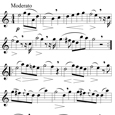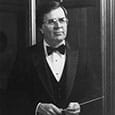Most flutists have a collection of exercise books, including those by Andersen, Altes, Hugues, Furstenau, Soussman, Kohler, Paganini, Karg-Elert, Casterede, Bitsch, and the list goes on and on. In comparison to the flute, the oboe repertoire has fewer offerings. However, one of their most substantial books is Apollon Marie-Rose Barret’s Complete Method for the Oboe, 1862.
Barret (1804-1879) was the solo oboist at Covent Garden for 45 years and oboe professor at the Royal Academy of Music in London. He wrote this method to teach his students and to demonstrate the mechanical improvements he had made in the design of the oboe. About a quarter of the way through the 219-page method is a set of Forty Progressive Melodies. Every oboist spends practice time with these melodies; they are some of the best pedagogical melodies ever conceived. Flutists will also learn from studying these melodies.
* * *
In the preface pages Barret writes, “The nuances or shades of expression give variety to music. In going from a pianissimo to a forte, and vice versa, an intermediate nuance is necessary to avoid an abrupt transition.” This intermediate nuance is illustrated below by the crescendo/diminuendo hairpin marks.
written
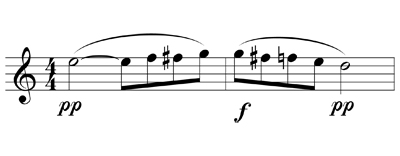
played
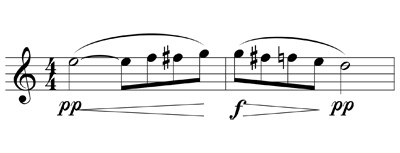
written

played

Barret suggests that it is a general rule to increase the tone in ascending passages and decrease it in descending passages. Barret presents several other musical examples demonstrating this idea. However, what becomes apparent to the modern reader is that Barret, and perhaps other composers of the period, uses the crescendo/diminuendo hairpin marks to illustrate the energy of the air stream to shape the contour of the musical line rather than a large crescendo followed by a diminuendo. He refers to this concept as giving nuance to the music.
Since Barret occupied a prominent position in the performance and teaching world in London, I have wondered if this concept of using the hairpins to illustrate the air speed was well-known by other wind players and composers. Thinking it was probably so, I began to experiment with this idea in other works written from the 1820s through the early 20th century. I found this concept worked exceptionally well in most cases.
Melody number 1 is in the key of C major and in rounded binary form. By definition, the rounded binary form is a musical form in two related sections. Each section is repeated. The form was popular in the Baroque period but was also used in short, one-movement works such as in this melody. The first section (A) begins in the key of C major and modulates in measure 8 to the dominant or the key of G major. The second section (B) continues the character of the first section for eight measures followed with the return of the first section (A) for the concluding eight measures. Rounded binary is labeled as A B A’. Breath marks outline each phrase.
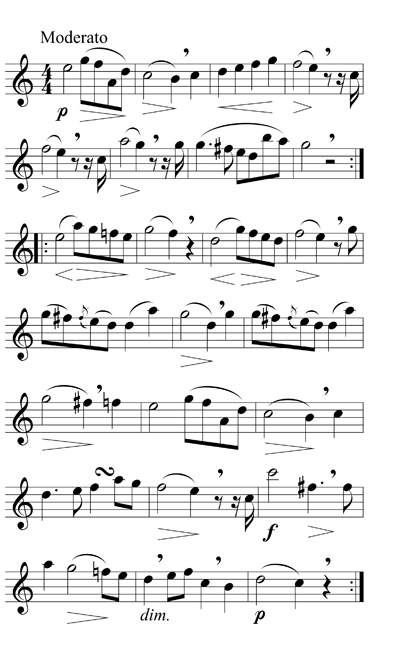
Two Notes under a Slur
A basic phrasing rule that works well in almost every instance is: “When playing two notes under a slur, the second note is played softer than the first, as in strong on the first note and weak on the second note. To explore this basic rule of phrasing, play measures 2, 4, 5, 6, 10, 12, 14, 15, 16, 18, 20, 22, and 24, with the first note louder than the second note.
Contour
Find the melodic contour of each phrase by drawing a line from one note head to the next, as if completing a child’s dot-to-dot puzzle. There are five basic melodic contour shapes: mountain, valley, going up, coming down, and gruppetto. The first four phrases (measures 1-6) are mountain-shaped phrases. The highest note in a mountain-shaped phrase is colored. You may add color by playing the note louder, softer, longer, or with faster vibrato. In the first phrase the G5 is highest note in the phrase. In the second phrase, the G5 is also the highest note, but in this case it is better to emphasize the F5 in the next measure because the F5 is on the first beat (a strong beat) and the G5 is on the fourth beat (a weak beat). The strength of the beat rule is always considered first.
Measures five and six are sequential phrases in that they present the same melodic contour and rhythmic structure only on different scale degrees. Play the first one with the crescendo to the F5 and the second one with the crescendo to the A5. Play the second phrase more loudly than the first because the A5 is higher than the F5.
The last phrase of the A section includes bars seven and eight. Phrase the pick-up G5 and the next three beats as one unit and beat four into the final G5 as another unit. These two grouplets are shaped in a coming down melodic contour format.
The interval connecting these two grouplets is a major sixth (D5 to B6). William Kincaid, the legendary Philadelphia Orchestra principal flutist, suggested lengthening the note before a skip of a perfect 4th or more. James Caldwell, who played principal next to Kincaid and later became the oboe professor at Oberlin Conservatory, suggested “imagine playing all the notes between the D5 to the B5” rather like a string player would slide from the lower note to the upper note. Joseph Mariano, former flute professor at the Eastman School of Music, took both Kincaid’s and Caldwell’s ideas and added “increase the vibrato speed on the end of the note before the slur.” Whatever you decide to do, you can be assured that many before you have thought long and creatively about playing wide intervals.
One Phrase vs. Another Phrase
The A section has five phrases. On a scale from 1 to 5, decide on the level of loudness for the top note of the phrase in relation to the top note in another phrase. One possible scheme could be: phrase 1, level 3; phrase 2, level 4; phrase 3, level 2; phrase 4, level 4; phrase 6, level 3 and phrase 7, level 4.There is no correct solution, so most musicians experiment and try several ideas. Record yourself to help decide which version sounds logical for the listener.
Pick-Up Notes
Phrases three and four begin with pick-up notes. Generally, pick-up notes are softer than the note that follows on the strong beat and are lifted into the next note. There is an articulatory silence between the pick-up note and the landing note. Articulate with a clean attack (thi, thi).
The B Section
The eight measures of the B section contain four, two-bar phrases (Measures 9-10, 11-12, 13-14 and 15-16). Measures 9-10 and 11-12 are in sequence. Play measures 9-10 at a level 3 and measures 11-12 at a level 2; remember to shape the contour of the individual phrase. The dynamic hairpin is to show air speed. Since measures 13-14 and 15-16 are identical, employ the echo rule on measures 15-16. Play measures 13-14 at a level 4 and measures 15-16 at a level 1. The grace notes are acciaccaturras and are played before the beat but as close to the beat as possible.
The A’ Section
Measures 17-20 are a repeat of the opening A section with a slight rhythmic change in measure 19. The gruppetto (group of notes in Italian) or turn (G5F5E5F5) is played on the upbeat of the third beat in the measure. The third beat and the gruppetto notes are slurred together.
The C6 in measure 21 is the highest note in the piece and also the one marked with the loudest dynamic (forte). The C6 is played at a level 5. Remember to follow the rule about playing pick-up notes on the C5 to the C6. The two F sharps in measure 21 should be separated so the listener hears two separate notes. Notice Barret has marked a small diminuendo on the first F sharp. He is reminding the player of the rule to decay (diminish) to the dot or tie.
T he rhythm in measure 22 is a syncopated rhythm. To enhance this add a slight separation between the first and second beats in the measure. In measure 23, follow the rule that notes of shorter note value lead to a note of a longer value (E5F5 to C5). The fourth beat in measure 23 is a pick-up into the final measure (lift, strong, weak).
Repetition
Once you can play this melody with the above directions, begin to work on melodic control. Can you play this melody the same way five times in a row? Ten times? It is a valuable asset to have control of your phrasing and execution of the notes when you perform excerpts for an orchestral audition setting. Remember Adam Kuenzel, principal flutist of the Minnesota Orchestra once said, “To win an audition you must be able to play perfectly for ten minutes.” (Flute Talk, January 2012). This is a good opportunity to practice to be perfect. Once you can execute this melody well as written, repeat the exercise at the octave.
